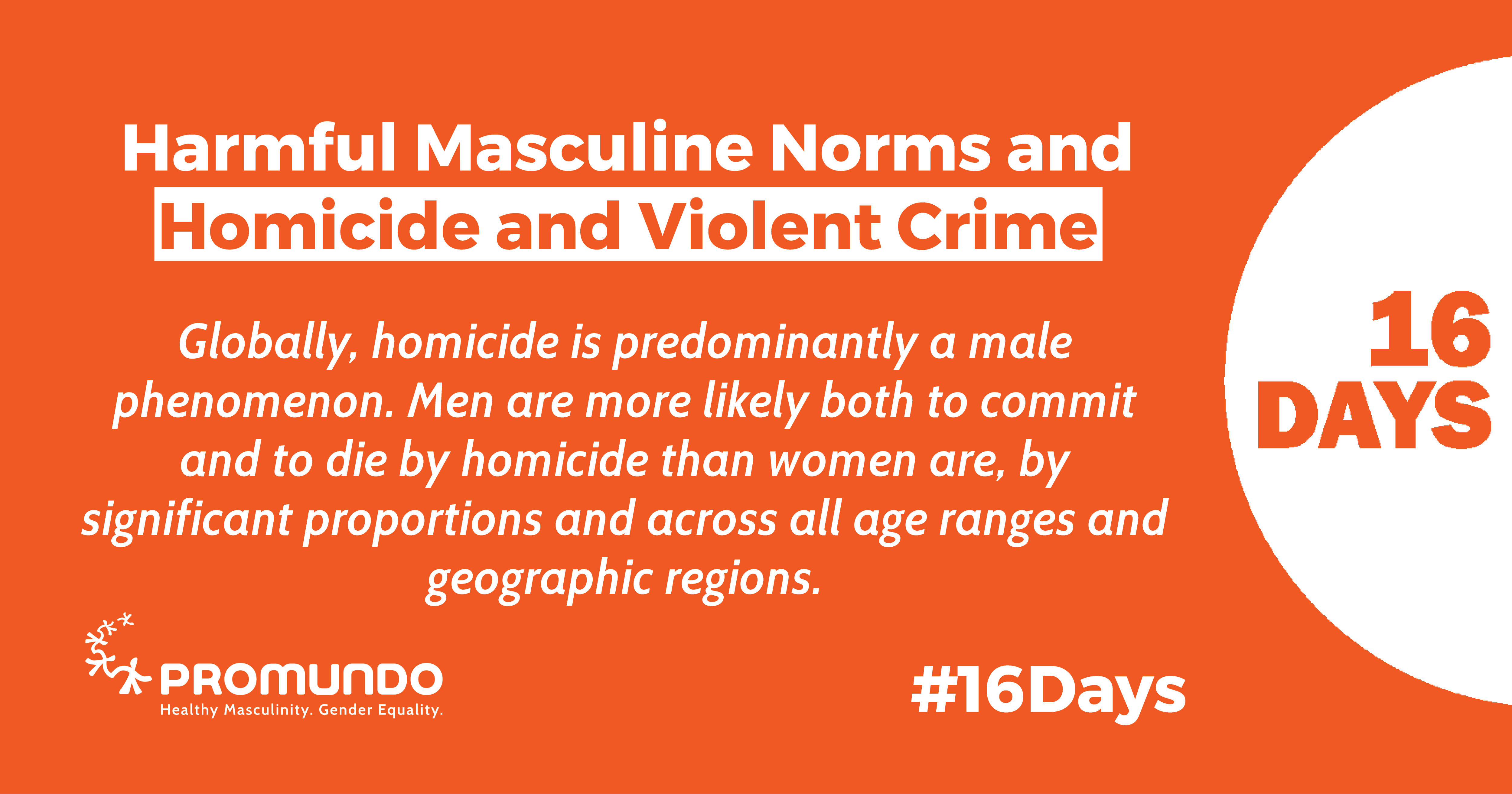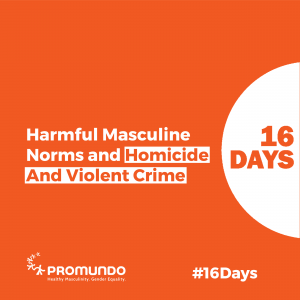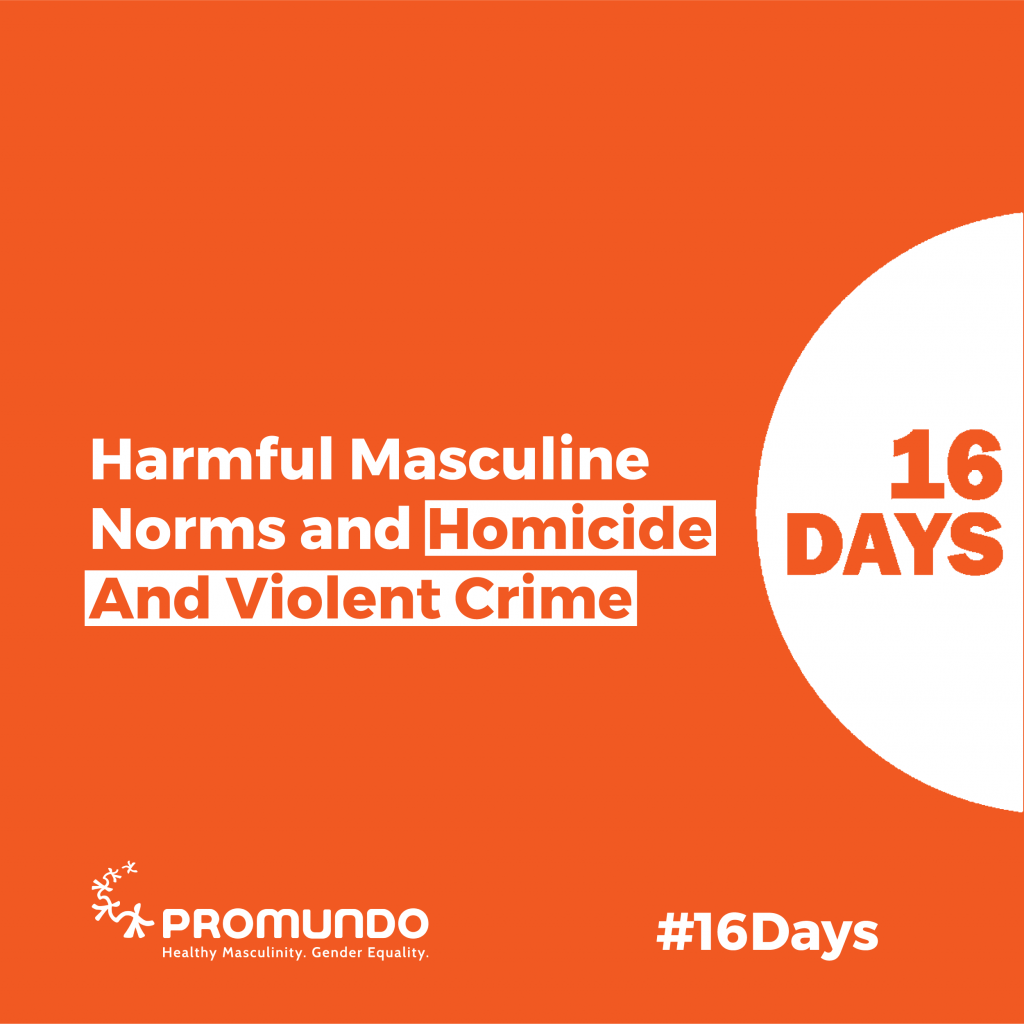The 16 Days of Activism Against Gender-Based Violence is an international campaign used by activists around the world (November 25-December 10) as an organizing strategy to call for the elimination of all forms of gender-based violence.
This year, we will be sharing out research on the links between harmful masculine norms and eight different forms of violent behavior, as well as insights and recommendations to eliminate all forms of violence.

While there is nothing inherent about being male that drives violence, how we socialize boys into their identities as men and what we expect of them – that is, society’s masculine norms – are undeniably linked with violence.
Indeed, boys and men are often raised, socialized, and encouraged to use violence in some form; on the whole, men and boys are disproportionately likely to both perpetrate most forms of violence and to die by homicide and suicide. However, the research affirms that this violence is preventable, gender equality is achievable, and nonviolent norms and ideas about manhood are prevalent and powerful.
Equimundo and Oak Foundation’s report Masculine Norms and Violence: Making the Connections, examines the links between harmful masculine norms and eight forms of violent behavior. This fifth blog in the Making the Connections, 16 Days of Activism series focuses on homicide and violent crime. It breaks down the facts on the issue, explores the links between homicide and violent crime and other forms of violence, and provides recommendations for action.
Homicide and Violent Crime
The Facts
Globally, homicide is predominantly a male phenomenon. Men are more likely both to commit and to die by homicide than women are, by significant proportions and across all age ranges and geographic regions. Additionally, mass killings – previously an occurrence that took place a few times every decade, and which are almost always committed by men – have been increasing in the United States since the 1970s.
With regard to other violent crime (apart from forms of violence addressed elsewhere in the report), decades of research demonstrate that men and boys are more likely to be perpetrators and victims than women and girls. Public violence is a common occurrence for men: According to IMAGES data from six countries, 3 to 36 percent of men reported participating in a robbery and 5 to 22 percent of men reported participating in fights.
The Links
Men and boys often use crime in various ways to demonstrate or prove their achievement of a certain form of masculinity. There has been a growing evidence base for understanding many forms of violent criminal behavior as innately linked with performances of hegemonic masculinity, alongside calls for increasing complexity in this analysis.
Men’s disproportionate likelihood of perpetrating homicide and violent crime is not biologically driven. Rather, these patterns are much more complex, and include a significant influence of masculine norms, social dynamics, and life conditions.
The Intersections
The research overwhelmingly and consistently shows that a number of prevailing factors must exist – if not an involved, intentional effort – to turn individual men into those who have killed. Researchers have studied how extreme trauma, humiliation, and shaming are nearly always part of the making of men who kill. Other studies have shown how the effects of particularly difficult childhoods and damaging relationships distort a human propensity not to kill others.
Research on men who have carried out mass killings in the United States varies but tends to point to a cluster of causes. Factors such as ubiquitous access to guns, undetected mental illness, social isolation, experiences of homophobic bullying, economic stress or grievance about losing something to which they feel entitled – such as jobs, prestige, privilege, or access to female partners – all combine with harmful masculine norms to increase the likelihood of pursuing this form of extreme violence.
From Theory to Practice
Efforts to prevent homicide and other violent crime with an explicit masculinities lens are rare around the world. Initiatives aiming to prevent homicide and violent crime should focus on the following transformations of harmful masculine norms:
- Engage men and boys in discussions about the connections between traditional masculinities, violence, and their negative consequences.
- Use nonviolent male role models who are similar to participants in age and other demographic factors in order to provide participants with an approachable, positive peer leader during programs.
- Provide a safe space for men and boys to learn and practice nonviolent forms of masculinity and to encourage male bonding and community building.

